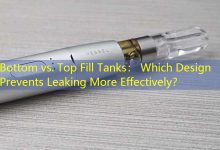
Introducción a Bottom vs.. Los mejores tanques de llenado en el mundo del vapeo, que evoluciona rápidamente, El diseño de los tanques de e-líquido juega un papel fundamental en la experiencia general del usuario.. Entre varios diseños disponibles, Los tanques de llenado inferior y superior siguen siendo dos de las opciones más populares entre los vapeadores.. La discusión sobre qué diseño previene las fugas de manera más efectiva es crucial tanto para los usuarios novatos como para los experimentados.. Este artículo profundizará en las especificaciones., ventajas, desventajas, y apuntar a la demografía de los usuarios de los tanques de llenado superior e inferior. Descripción general y especificaciones del producto Los tanques de llenado inferior están diseñados con el depósito de e-líquido ubicado en la base del dispositivo. El diseño generalmente incorpora un mecanismo de absorción más complejo que atrae el líquido hasta la bobina....

Inferior Vs. Flujo de aire superior: ¿Cómo afecta la posición de entrada de aire a la calidad del vapor?? Muchos entusiastas del vapeo saben que el flujo de aire juega un papel fundamental en la producción y calidad del vapor.. Sin embargo, Lo que muchos no se dan cuenta es cómo la posición de la entrada de aire (específicamente el flujo de aire inferior versus superior) puede afectar significativamente la experiencia general de vapeo.. Este artículo profundizará en los matices entre los sistemas de flujo de aire inferior y los sistemas de flujo de aire superior., examinar cómo sus configuraciones afectan la calidad del vapor, sabor, y satisfacción del usuario. Comprender el flujo de aire: Conceptos básicos El flujo de aire en los dispositivos de vapeo es responsable de entregar el aire necesario para vaporizar el e-líquido.. La posición de la entrada, ya sea en la parte inferior o superior, puede alterar la forma en que este aire interactúa con la salida de vapor y sabor.. Los factores clave incluyen la turbulencia., enfriamiento,...

# Relleno superior vs.. Relleno inferior: ¿Qué diseño de tanque es menos propenso a tener fugas?? En el mundo del vapeo, La elección entre diferentes diseños de tanques puede afectar significativamente la experiencia del usuario.. Dos diseños comunes son los tanques de llenado superior y de llenado inferior.. Cada diseño presenta ventajas y desafíos únicos., particularmente en lo que respecta a su susceptibilidad a las fugas. Este artículo profundizará en una comparación en profundidad de los tanques de llenado superior y de llenado inferior., explorando sus especificaciones, uso, actuación, ventajas y desventajas, y la demografía del usuario objetivo. ## Descripción general del producto y especificaciones ### Tanques de llenado superior Los tanques de llenado superior están diseñados para llenarse desde la parte superior, haciéndolos convenientes y más fáciles de recargar. La mayoría de los modelos cuentan con una tapa superior atornillable o deslizable que permite....

Cómo prevenir inundaciones en los tanques de flujo de aire inferiores en el mundo del vapeo, El diseño y la funcionalidad de los cigarrillos electrónicos desempeñan un papel fundamental para garantizar una experiencia óptima.. Un problema común al que se enfrentan muchos vapeadores es la inundación de los tanques de flujo de aire inferiores.. Este dilema no sólo compromete el sabor sino que también puede llevar a una situación complicada.. En este artículo, Exploraremos estrategias efectivas para prevenir inundaciones en los tanques de flujo de aire del fondo., enfatizar buenas prácticas de mantenimiento y comparaciones de productos que potencialmente podrían resolver este problema. Comprender la inundación en los tanques con flujo de aire inferior La inundación ocurre cuando el exceso de e-líquido llena el tanque y abruma la mecha.. En diseños de flujo de aire inferior, donde el aire entra desde abajo, la combinación de gravedad y flujo de aire puede exacerbar los problemas de inundaciones....

Introducción a la tecnología de flujo de aire inferior En el mundo del vapeo en constante evolución, Los entusiastas buscan constantemente formas de mejorar su experiencia.. Uno de los avances más importantes es el sistema de flujo de aire inferior., que ha ganado considerable atención por su producción de sabor superior.. Este artículo profundiza en las razones por las que los diseños de flujo de aire inferior son los preferidos tanto entre los vapeadores principiantes como entre los experimentados.. Comprender la producción de sabor La producción de sabor en el vapeo está influenciada por varios factores, incluyendo la composición del e-líquido, configuración de la bobina, y dinámica del flujo de aire. Entre estos, El flujo de aire juega un papel fundamental para mejorar o restar valor a la experiencia de vapeo.. La ubicación del flujo de aire puede afectar drásticamente la forma en que se perciben los sabores.. Las ventajas del flujo de aire inferior Los sistemas de flujo de aire inferior se han convertido en una opción más robusta..

How To Fix Leaking Issues In Bottom-Fill Tanks When it comes to vaping, nothing is more frustrating than a leaking bottom-fill tank. This issue can not only waste your e-liquid but also damage your device and create a mess. Understanding how to fix leaking issues in bottom-fill tanks is crucial for a seamless vaping experience. En este artículo, we will explore common causes of leaks and provide step-by-step solutions to help you resolve the issue effectively. Understanding Bottom-Fill Tanks Bottom-fill tanks are designed for convenience, allowing users to refill e-liquid easily without having to detach them from their devices. Sin embargo, their design can sometimes lead to leaking issues. The key elements contributing to leaks include O-rings, airflow control, and the...





